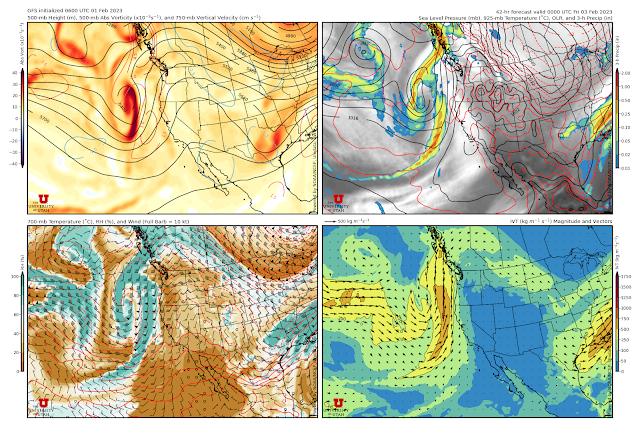Thanks to the active pattern that has dominated over the past several weeks, we haven't had much in the way of poor air quality so far this winter, but that is changing temporarily this week.
The setup was the passage of an intense but shallow cold front on Sunday, which dropped temperatures in the Salt Lake Valley to well below average. At the Salt Lake City Airport, the min/max temperatures on Monday were 9/20 and on Tuesday 10/25, compared to a 30-year average (1991–2020) on those days of 10/25.
At the same time, temperatures aloft have begun to climb as a ridge builds over the area. Early Tuesday morning, temperatures on Mt. Baldy above Alta were about -2˚F. This morning they are around 10˚F.
A look at this morning's sounding from the airport shows a 4.2˚C (7.5˚F) inversion based at about 825 mb, or about 1500 feet above the valley floor.
 |
| Source: SPC |
As the inversion developed yesterday, pollutants began to build up in the valley. I have friends visiting from Innsbruck and took them to Alta where we had a great day introducing them to the Greatest Snow on Earth. However, a late afternoon trek out the High -T showed the pollution lurking below.
Indeed, the time series of PM2.5 at Hawthorne Elementary shows concentrations rising into the low end of moderate air quality yesterday afternoon and then continuing to climb overnight to 25.5 ug/m2 before subsiding slightly to just over 20 in the early morning hours.
A saving grace so far is that the event is young and the base of the inversion is elevated. That means that instead of pollutants being trapped very near the valley floor, they are dispersing through a layer that is about 1500 feet deep. The sounding above showed that the atmosphere was well mixed in that layer, at least for now.
The GFS, however, forecasts the movement of an upper-level ridge over Utah over the next two days, with the ridge axis parked right over us by 0000 UTC 3 February (5 PM MST Thursday).





Great year for snow and great year for air quality compared to most winters, hope the trend continues. The 12Z GFS did not trend in the right direction for this weekends storm...
ReplyDeleteI have no training in meteorology. Is there an easy resource I could use to find an elevation that would allow me to get up out of the inversion?
ReplyDeleteThe top of the air pollution varies. Most commonly it is near or below 6000 feet, but it can be deeper and there are times it is near or below 5000 feet.
DeleteI use https://www2.purpleair.com/ to get a handle on the depth of the inversion. Click on "map" at the top.
I think the climo normal for those awfully cold days is 40/25…
ReplyDeleteI'm just glad there is not a lot of snow cover in the valley (except in the shade). I find the inversions much worse when convective mixing is suppressed by snow.
ReplyDeleteHas anyone seen Albert Gore?
ReplyDeleteSaw him on TV the other day. What, you think global warming means “no more winter”?
DeleteWhat are the trends over the pandemic? Was there a decline in SLC pollution levels during the lock downs and this is now reversing? Kurt Fisher
ReplyDeleteI don't know the answer to that. Some effort would be needed to control for the meteorology. Also, during the first year, the pandemic kicked in in March, after the inversion season. By the start of the next inversion season, WFH was common, but travel had picked up some. Still it would be interesting to look at.
DeleteTurns out there is someone who has looked at this: https://atmos.utah.edu/air-quality/covid-19_air_quality.php
Delete